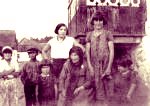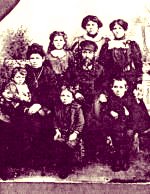| home | cemeteries | worth to know | guest book | write to us |
| JELENIEWO |
The village Jeleniewo was established in the 18th century by Antoni Tyzenhaus. There were 64 households hosting 471 people and from the very beginning Christians lived here together with Jews. In Yiddish they named this place Yelenevi. The oldest preserved public registers of Jews date back to years 1808 - 1825. In that period 83 children were born and 31 couples got married. We can trace even some family names like Brak, Brzeziński, Dawidowski, Derner, Frampolski, Frank, Garbarski, Hertman, Krzymiański, Lubowski, Lubowicz, Nowowieski, Millethal, Perlstein, Przybylski, Rogowski, Smolnicki, Steinberg, Sztejndorf, Sztejnbret, Urwicz, Wilgocki, Winkielman, Wołomański, Wróblewski, Żyniewski. In the years 1872 - 1882 Jakow Gordon was Rabbi in Jeleniewo and he was followed by Jehuda Jakow Zimerman and Meir Lieberman. |
||
Gitel Winkielman and her family. Picture was taken in 1932. In the background there is most likely the Jewish district, on present-day Sportowa Str. Gitel died one year later. |
||
In 1880, 659 people lived in Jeleniewo and half of them were of the Moses confession. But gradually the number of inhabitants decreased to 471 people in 1921, including 175 Jews. Tania Katzir, maiden name Lis, before the Second World War lived in the nearby town of Suwałki. Here are some memories from her early years: ''Jews in Jeleniewo lived very modestly. They mainly worked in agriculture and tailoring. They would leave Jeleniewo on Sunday and worked in Suwalki until Thursday. They would return home before the Sabbath. As some of the Jews departed Jeleniewo for Suwalki on Sundays, they would buy all kinds of farm animals, such as horses, cows, chickens to be sold in the city. Almost everyone in village of Jeleniewo had cows and horses on their property. Houses were simply, wooden and covered with roof made of straw. The rooms were very modest. Most of houses consisted of one room and a kitchenette, while others were slightly larger, having, perhaps, two rooms or more. Some houses were somewhat nicer, having been constructed with a sturdy wooden roof rather than the one made of straw. In the middle of the village there was a small lake where there were lots of geese and other birds around which dwelled approximately thirty Jewish families. A little further away there was a church around which the Christian community lived. The synagogue was located at a nearby street, surrounded by houses. In the back of the synagogue there was the cemetery. The rabbi lived opposite the synagogue. The shames, Yakov with his wife Brayna lived in the vicinity". |
||
Possibly Mosze Winkielman and his children: Rebecca, Arthur, Harry. Mosze was a first cousin of Herman Storick's grandmother. Picture was taken in 1890. |
||
There is no preserved picture of the synagogue from Jeleniewo. In the archive of the Jewish Historical Institute there is kept only one protocol mentioning that building: "On the 13 of January 1927 Commission consisting of M. Niemieński - district doctor, Bolesław Araszkiewicz - administrator of a group of villages in the neighborhood of Jeleniewo and Jan [...]kowski - local police commissioner made an inspection of sanitary conditions of existing synagogue and stated as it follows: The Jewish Community in Jeleniewo consists of 161 people of the Moses confession and have a synagogue in the same village. The synagogue exists around 100 years. There is no building permit. The synagogue is situated in a brick building built specially for that purpose. (...) There are no stairs by the entrance. The building needs to be redecorated and refreshed". |
||
Arthur and Gitel Rosenberg Winkielman. Arthur emigrated to the United States of America. In 1932 he came to visit his family when this picture was taken. |
||
The shtetl of Jeleniewo does not exist any more. It was destroyed during the Second World War. There is no longer the Jewish blacksmith Fajwel Winkielman nor the shoemaker Izak Wartelski nor the butcher Dawid Frydman... There is not much information about the fate of Jews from Jeleniewo. Some of theme tried to escape to Lithuania and there they perished. All who stayed in the village were taken away by the Nazis to some unknown place. In the Museum of the Holocaust in Jerusalem there is a record of an interview with Wacława Sznurkowska who used to live in Jeleniewo. In her memories she described the deportation of local Jews: "A part of them was taken on one day and a second part later. First they took the young ones and then they deported the old ones and women. They took them to Suwalki and from Suwalki I do not know where. Chaika (Mrs Sznurkowska's Jewish friend) told me that part of our men were deported to Augustow. I asked her: "Chaika, what is going to happen next?" and she answered: "When I will learn, I will come and tell you". But she did not come anymore. Not any of them returned to Jeleniewo. No one of the Jews returned. They did not come back. Not even one. Nobody.". |
||
 |
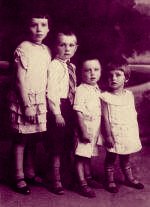 |
|
Szlomo Michałowski. Born in 1936. Victim of Holocaust. |
Children of Mosze Aaron and Masza (Powiatowski) Michalowski. They all died during Holocaust. |
|
Jews from Jeleniewo most likely were murdered during mass executions or in the gas chambers of one of the death camps. As time went by the inhabitants of the village, little by little, forgot about their former neighbours. In 1989 Herman Storick, a New Yorker and a descendant of Jews from Jeleniewo visited the ancestral village. Here there is his story about his roots: "When I was a child my mother told me stories about a village called Jeleniewo. I also heard about my uncle, his wife and five children who decided not to emigrate to the United States but decided to stay and to continue the tradition of living in the village. Our Jewish history in Jeleniewo begun more than two hundred years ago. My aunt Malka Michałowska left this village as a young woman and emigrated to the United States. She worked very long hours and with her limited earnings she was able to send for her sister Chana. Together both sisters sent for their younger sister, sixteen years old Rejzel Michałowska. She was my mother. It was 1912 when my mother left for the unknown world of New York, taking with her memories of the family she left behind. |
||
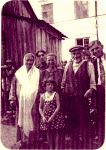 |
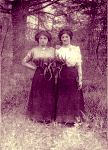 |
|
Jews from Jeleniewo - 1932 Probably Sara & David Blacharski |
Sisters Chana and Malka Michałowski. They emigrated from Jeleniewo to America. |
|
During the early years of the first world war my grandfather of blessed memory died at a young age. His name was Zalman Icchak Michałowski. He was born in a village of Taciewo and he and his young children are buried in the cemetery of Jeleniewo. I do not know where their graves are. Soon the three sisters sent for their widowed mother, my grandmother Chaja Fejga Winkielman Michałowska and her son Simon, leaving behind in Jeleniewo my uncle Mosze Aaron Michałowski, his wife Masza Michałowska and five children. They all died during the Holocaust. They are not buried in the cemetery of Jeleniewo. Perhaps they rest in a certain unmarked grave far away from their village. Perhaps in Treblinka". For information about fate of his family members Herman Storick had to wait till 2008. The German records concernig Jews from Jeleniewo were confiscated shortly after the war by the Soviet authorities and were not made public. After many years the data was transferred to International Red Cross office in Arolsen. Let us quote some of these records: "Mowza Aaron Michalowski, born 1897, the last known place of stay: Kalwarija, Lithuania", "Masha Michałowska, born 1921, deported to Lublin", "Yankiel Michałowski, deported with his mother and siblings to a concentration camp", "David Michałowski, born 1928, deported with his mother and siblings to a concentration camp", "Masha Michałowska, born 1903, deported to a concentration camp", "Zelda Michałowska, born 1923, deported with his mother and siblings to a concentration camp", "Sarah Frida Michałowska, born 1928, deported to a concentration camp", "Shlomo Michałowski, born 1936, deported to a concentration camp". |
||
The Michalowski family. Between parents, top row left, is Rejzel Michalowska, the mother of Herman Storick and Rebecca Winkielman, a close relative, top row second from the right. Picture taken approx. 1907 |
||
In the village Herman did not find many traces of his ancestors. The whole Jewish district was almost destroyed. In the former place of the synagogue at 14, Sportowa Street there was a house built after the Second World War. Herman Storick also found property owned by his ancestors (families Michałowski and Winkielman). Herman Storick never entered that house. He did not want to scare the people who live there. He did not want have them think he would lay claim to that estate. He would never wish that. In the neighbourhood there was an old Jewish cemetery as well. Years of oblivion almost caused the complete devastation of that necropolis. The whole area was overgrown, and finding any grave seemed to be impossible. The condition of that place was alarming. Then, during his first visit, Herman Storick and his wife Cecilia decided that the cemetery has to be tided up. After hard work carried out in the following years and the removing of bushes and thickets some matzevot were discovered. Among them there were gravestones of members of Herman Storick's family: great grandmother Roza, daughter of Lejb, who died in 1869 and great great great grandfather Azaria Fajbisz who died in 1853. |
||
 |
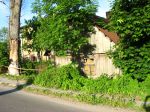 |
|
After war building at 14, Sportowa Street . The site of the synagogue. |
One of a few preserved houses in the Jewish district built before the Second World War. |
|
In 1992 a monument commemorating the Jews from Jeleniewo was installed and placed near the entrance. It was designed by Cecilia Storick. On the plain stone there is an inscription: "In love they are remembered and in memory they live. Commemorated to Jews from Jeleniewo who found their last place of rest at that cemetery and to those others who were deported to places of extermination in the years 1939 - 1945. May they rest in peace". The unveiling of the monument took place on the 30th of August 1992 and appeared to be a very important event in the small village. To Herman Storick's surprise many inhabitants took part in that ceremony. In the following years the cemetery was enclosed with a stone wall. By the entrance there were placed few plaques with a part of the 23rd psalm in Polish and Hebrew and one with the characteristic words of pope John Paul II: "Those Jewish cemeteries are part of our common past. There are places with deep spiritual and historic meaning. May those places unite Poles and Jews in their anticipation for the day of the Last Judgement and Resurrection". New Polish friends of Herman Storick got involved in his actions: priest Władysław Podeszwik - rector of the local parish, Maria Szymanowska - translator, Jan Jagielski from the the Jewish Historical Institute, Krzysztof Malczewski from Jewish Heritage Tours as well as members of The Borderland Foundation. Thanks to the efforts of Herman Storick, Jan Jagielski and The Borderland Foundation, a pamphlet "Jews from Jeleniewo" containing the history of Jews and information about cemetery was published. |
||
 |
 |
|
Herman & Cecilia Storick in Jeleniewio |
Herman Storick & Wacława Sznurkowska |
|
During a visit to Poland, Herman Storick recorded a video entitled "A PIlgrimage to Jeleniewo". This was a pilgrimage to his ancestral village along with the reconsecration of the ancient Jewish cemetery. The video was shown on TV stations, local churches and synagogues. Below is a short clip of the recording. |
||
Before the second World War there were around 500 gravestones in the cemetery. Most of them were destroyed during the war by the Nazis who used them for construction and road work. Some gravestones were stolen after the war. In recent years an inventory was carried out that revealed 31 graves. Most likely, underground there are many more matzevot. Close to the entrance gate foundations of destroyed gravestones are also visible. Matzevot form Jeleniewo were mostly carved in granite stones from nearby fields, source very popular and with easy accessibility in the Suwalki area. Hebrew inscriptions are usually short. Because for many years Jews did not use family names, most of the matzevot have only the name of the deceased and his/her father's name. There are only two gravestones containing family names. One belongs to Chaim Wartelski who died in 1864 and the second one belongs to Jakub Postawelski who died in 1914. Most matzevot are from the mid 19th century and the oldest one identified dates back to year 1765. The Jewish cemetery in Jeleniewo has landmark status. |
||
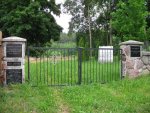 |
||
| Jewish cemetery in Jeleniewo | ||
The necropolis is situated from the direction of Suwalki. There is a narrow path between houses at 20 and 22 Suwalska Street that leads straight to cemetery. The place is under care of Mr. Józef Pilichowski who lives in Jeleniewo. In accordance with Herman Storick's wish the entrance gate is always open for visitors. |
||
 |
||
| Tanya Katzir-Lis and Herman Storick. Holon, November 2008. | ||
When Herman Storick visited the village for the first time, many of the inhabitants did not know that people of the Moses confession used to live here. In June 2006, on one warm evening, I sat in an inn "Pod Jelonkiem" ("Under Fawn") in Jeleniewo. Right next to me there was a loud group of students. Most of them did not come from the village. Suddenly one of them, most likely an inhabitant of Jeleniewo, said to his friends: "Here, opposite, used to be a synagogue and the Jewish district and further on there is a Jewish cemetery with very old grave stones. That place for years had been forgotten until some American came and restored it. It is a very interesting place". In his voice I could hear a kind of pride fabout the cultural heritage of his home village. I wish Herman Storick could have heard that....... |
||
Matzevot of Jeleniewo |
|
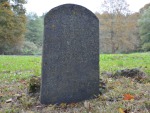 |
Who were beloved and pleasing in their lives and in their deaths are not separated. |
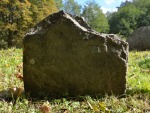 |
Here lies our dear mother, the modest Nechama, |
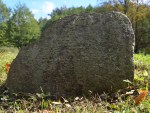 |
Here lies our teacher Samuel, son of our teacher Nachum HaCohen*. *Descendant of a priestly family. |
 |
..(Our) dear (mother?), the modest woman Esther. (Complete text illegible). |
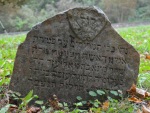 |
With a voice of lamentation and bitter crying on the passing |
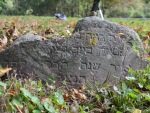 |
(Partial inscrption missing) |
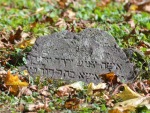 |
|
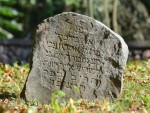 |
|
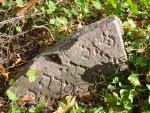 |
(Partial inscription missing) |
 |
Here lies our father and teacher, the righteous man Tzvi, |
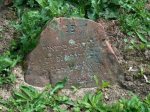 |
Here lies the distinguished rabbi and teacher Shaul, son of our teacher Yehuda. |
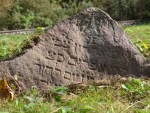 |
Here lies my father and teacher Aaron Tzvi, son of our teacher Ephraim Katz*. *Katz can either be a family name or an acronym of Kohen Tzeddek, |
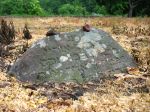 |
Here lies my father and teacher Azaria (Uri?) Faivish (Faibush), |
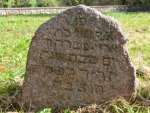 |
Here lies my mother and teacher Chaya (?), daughter of Arieh (?). |
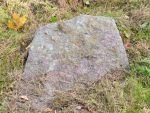 |
text illegible |
 |
Here lies the married woman Baila Leah, daughter of our teacher Tzvi. |
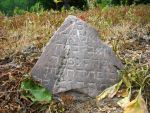 |
Here lies my father and teacher Arieh Ze'ev, son of our teacher Yitzchak. |
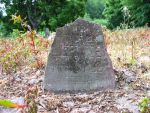 |
Here lies my mother and teacher Devorah, daughter of Yosef (Joseph) Ha-Levi*. |
 |
Here lies my father and teacher Shalom, son of our teacher Moshe (Moses). |
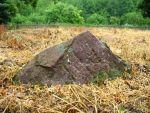 |
text illegible |
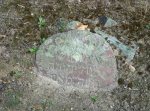 |
Here lies the righteous man, our teacher Rabbi Yehuda, The remaining text and date is illegible |
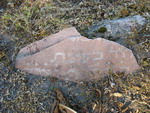 |
text illegible |
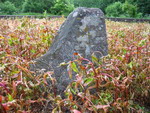 |
Here lies our teacher Rabbi (?) Eliezer (?), |
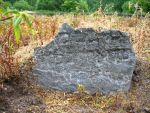 |
Partly illegible |
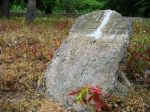 |
Here lies Bracha Baile (?), daughter of...(?) Katz*. Remaning text is partially illegible. |
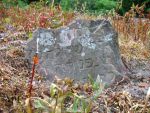 |
(Here lies)......daughter of Shraga Katz*. Text on stone is mainly illegible. |
 |
Here lies Michel (?), daughter of Shaul (?) of blessed, righteous memory. |
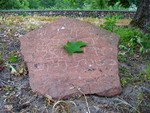 |
Here lies Leib, son of Isaac of blessed memory.
|
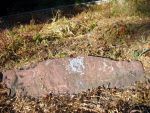 |
(Female - name unknown). Died (in the year) 5568 (1808). Portion of stone remains underground |
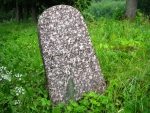 |
Here lies the honored, dear, G-D fearing, good hearted, righteous man, |
Text: Krzysztof Bielawski In the description excerpts of the pamphlet "Jews from Jeleniewo", edited by Jan Jagielski of the Jewish Historical Institute and published by the Borderland Foundation were used. English translation by Katarzyna Nocek, Herman Storick, Krzysztof Bielawski If you want to get a free copy of Polish written pamphlet "Jews from Jeleniewo", please write to us! |
|
| home | cemeteries | worth to know | guest book | write to us |

